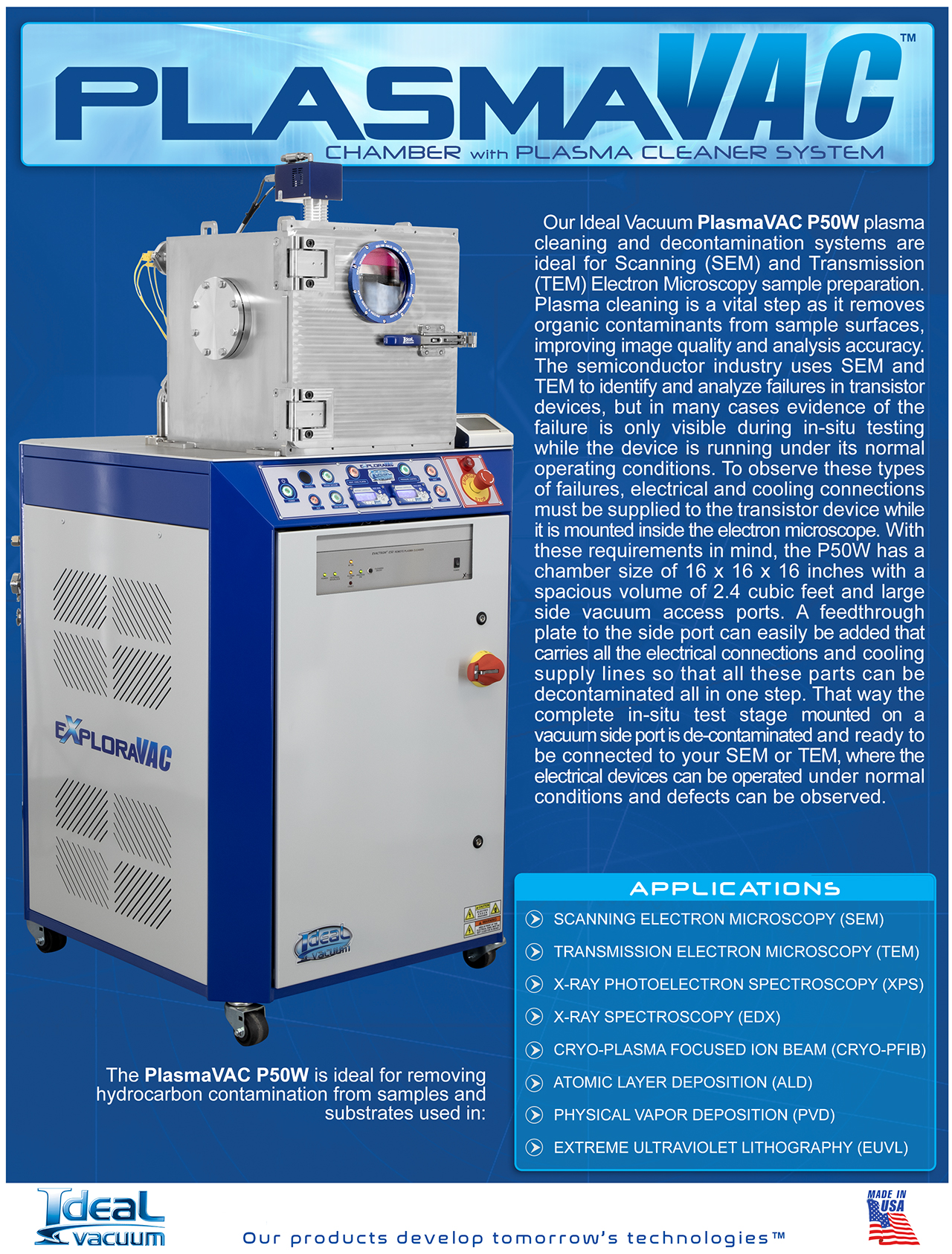XEI Scientific Evactron E50 E-TC De-Contaminator Remote Plasma Source Commonly Used For SEM, TEM, ALD, & PVD Sample and Substrate Preparation.
The XEI Scientific Evactron E50 E-TC de-contaminator system consisting of: Evactron E50 E-TC remote plasma radical Source, with gas purge option, Evactron E50 E-TC rack-mount controller, Evactron E50 E-TC touchpad interface, system user manual, and Evactron E50 cable set. These are integrated component of our Ideal Vacuum
PlasmaVAC P50W plasma cleaning and decontamination systems which is an ideal product for Scanning (SEM) and Transmission (TEM) Electron Microscopy sample preparation. Plasma cleaning is a vital step as it removes organic contaminants from sample surfaces, improving image quality and analysis accuracy.
Plasma Cleaning is vital for removing hydrocarbon contamination from samples and substrates used in:
- Scanning Electron Microscopy (SEM)
- Transmission Electron Microscopy (TEM)
- X-ray Photoelectron Spectroscopy (XPS)
- X-ray Spectroscopy (EDX)
- Cryo-Plasma Focused Ion Beam (Cryo-PFIB)
- Atomic Layer Deposition (ALD)
- Physical Vapor Deposition (PVD)
- Extreme Ultraviolet Lithography (EUVL)
Evactron E50 E-TC surface treatment specifications:
- Remote Plasma Source by XEI Scientific
- Model Evactron E50 E-TC
- Power Adjustable Between 35 to 75 Watts
- Max of 50 Watts Continuous Operation
- RF Frequency at 13.56 MHz
- Two Gas Inlet Filter Options: 3 nm & 0.5 µm Pore Sizes
- The 3 nm Pore Sizes Follows Semiconductor Industry SEMI F38-0699 Directive
- Tested With O2, CDA, Ar/ H2, Ar/O2, N2/H2, and N2 Gases.
- Dedicated Evactron User Interface Controller
- Storage Of User Settings
- Recipes, Power, Cycles, and Length of Cleaning
Plasma cleaning is a technique widely used in microscopy, including Scanning Electron Microscopy (SEM) and Transmission Electron Microscopy (TEM), to prepare and decontaminate samples. It effectively removes organic contaminants from sample surfaces, improving image quality and analysis accuracy. Here's how plasma cleaning works for SEM & TEM samples:
1. Principle of Plasma Cleaning
Plasma cleaning uses plasma, a highly ionized gas, to remove contaminants. Plasma is generated by applying a high-frequency electromagnetic field to a low-pressure gas, commonly oxygen, argon, or hydrogen. The process creates ions, electrons, and neutral species that are highly reactive.
2. Removal of Contaminants
In the plasma cleaning process:
- Physical Removal: The energetic ions in the plasma bombard the sample surface, physically sputtering away contaminants.
- Chemical Reactions: Reactive species in plasma can chemically interact with contaminants. For example, oxygen radicals can oxidize organic materials, turning them into volatile compounds that are easily removed.
3. Application in SEM and TEM
For SEM samples:
- Decontamination: Plasma cleaning removes organic residues like fingerprints, oils, and airborne particulates that can obscure details or interfere with electron beams.
- Improved Imaging: By cleaning the surface, plasma treatment reduces charging effects and enhances the resolution and contrast of SEM and TEM images.
- Enhanced Resolution and Contrast: A clean sample surface allows for better interaction between the electrons and the sample, which is critical for achieving high-resolution and high-contrast images in SEM and TEM.
- Preparation for Coating: It's often used prior to applying conductive coatings to non-conductive samples, ensuring the coating adheres well and is uniform.
4. Advantages of Using Plasma Cleaning
- Gentle on Samples: Unlike chemical cleaning methods, plasma cleaning is generally non-destructive to the sample surface.
- Fast and Efficient: The process can take from a few minutes to an hour, depending on the contamination level and the sample size.
- Versatile: Effective on a variety of materials, including metals, ceramics, and biological samples.
